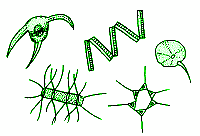 |
 |
Conference Papers
Biodiversity of Seaweeds in southern Australia
Prof. Margaret Clayton, Dr Karen Kevekordes &
Dr Monica Schoenwaelder
Department of Biological Sciences
Monash University
Clayton 3168
|
The workshop began with an informal lecture exploring what scientists mean by the term "biodiversity" and a review of the key features of seaweed biodiversity in Australia. Some of the threats to seaweed/marine biodiversity were then discussed, and a research project investigating the impact of secondarily treated sewage effluent on seaweed diversity was outlined. |
 |
This was followed by a practical session learning to identify some common seaweeds with the chance to examine them microscopically. Information about how to press and preserve specimens was distributed. Finally there was a slide show depicting the microscopic private life of some local seaweeds, with detailed images illustrating how they reproduce and disperse.
Until now the biodiversity debate has largely belonged to terrestrial biologists, especially taxonomists and the ecologists and conservation biologists who started it. They have successfully used the emotional appeal of large mammals and species-rich tropical rainforests to highlight the urgent global need to stop habitat destruction and conserve the earth’s biota.
We are marine biologists, and it is our responsibility to ensure that the biodiversity debate takes full account of the significance of marine ecosystems. We must encourage debate on biodiversity, and help to ensure that marine organisms, in particular, do not remain "out of sight and out of mind".
"Biodiversity" is defined, according to article 2 of the Convention on Biological Diversity signed by 156 nations at UN Conference on the Environment and Development (The Earth Summit), 1992, as the "..variability among living organisms from all sources including inter alia terrestrial, marine and other aquatic systems and the ecological complexes of which they are part; this includes diversity within species, between species and of ecosystems."
Thus, biodiversity is a concept that unifies different branches of biology. Until recently scientists from the disciplines of genetics, systematics and ecology each tended to view biodiversity as referring to their own component. Now many biologists are beginning to recognise that only by integrating these disciplines can we achieve a balanced perspective on the ecology and evolution of life on Earth.
International conventions provide the rationale and essential impetus for National and State biodiversity legislation. Information on many different biodiversity-related issues is available from a variety of sources, and in particular I recommend the following internet sites: http://www.biodiv.org.chm.html and http://www.environment.gov.au/life/chm/chm2.html.
We need to be aware of some special characteristics of seaweed biodiversity in general and in southern Australian in particular. Algae encompass a much greater range of genetic diversity than higher plants or many animal groups. Like marine ecosystems in general, they have high diversity at the phylum level. They include a greater number of different types of organism and different types of body plan. Marine organisms are physiologically and genetically more distinct than land assemblages. This is true of marine algae as well as marine animals.
Unlike land plants, the greatest seaweed species diversity is not in the tropics, but is found in temperate ecosystems. Bolton (1994) identified very rich seaweed floras in four regions of the world, including three temperate regions: Japan, the Mediterranean and, based on Professor Bryan Womersley’s analysis, southern Australia. Together with the very high level of endemism that characterises the seaweed flora of southern Australia, the high species diversity provides a compelling rationale for adequate conservation measures.
It is recognised that there are a variety of well known and widely recognised threats to marine biodiversity. We discuss one particular threat, the effects of treated sewage effluent, as a case study. Effluent discharge has a number of adverse effects on seaweed including: a decrease in percentage cover, a reduction in species diversity, and a change in the algal community structure due to the replacement of pollution sensitive species with pollution tolerant species (Brown et al. 1990). These changes can be quantified and used as an indicator of environmental disturbance.
We believe marine biologists must be more assertive in the biodiversity debate. In marine ecosystems, as in terrestrial ecosystems "human activity threatens losses in aesthetic quality of world, economic opportunity and ecosystem services" (Erlich & Wilson 1991).
References
Bolton, J. J. 1994 Global Seaweed Diversity: Patterns and anomalies. Botanica Marina 37, 241-245.
Brown, V. B., Davies, S. A. and Synnott, R. N. 1990 Long-term monitoring of the effects of treated sewage effluent on the intertidal macroalgal community near Cape Schanck, Victoria, Australia. Botanica Marina 33, 85-98.
Erlich, P. and Wilson, E. O. 1991 Biodiversity studies: Science and Policy. Science 253, 758-761.